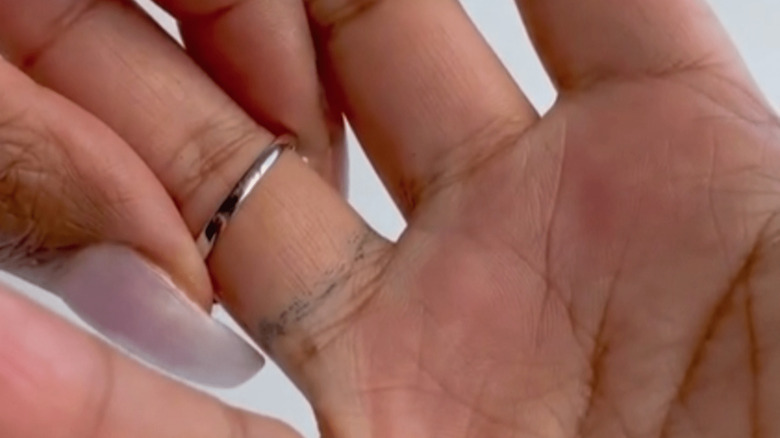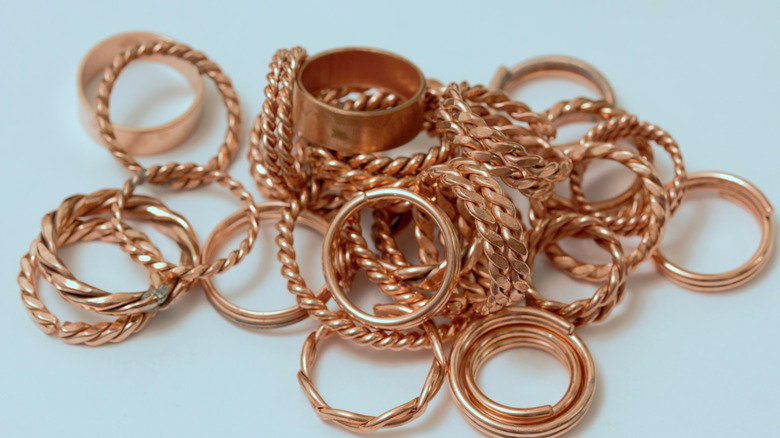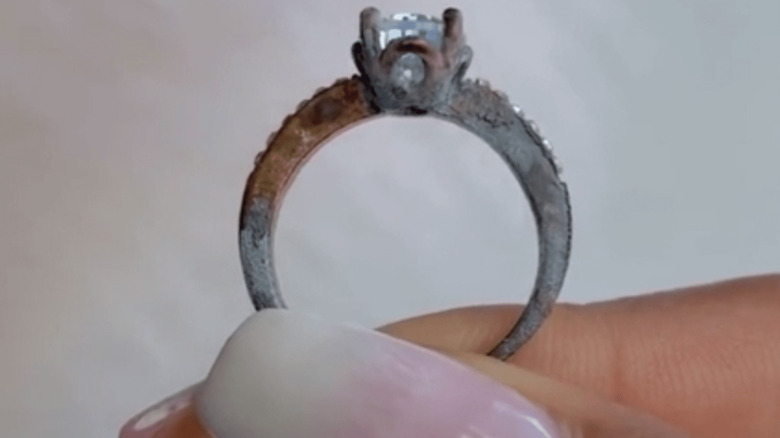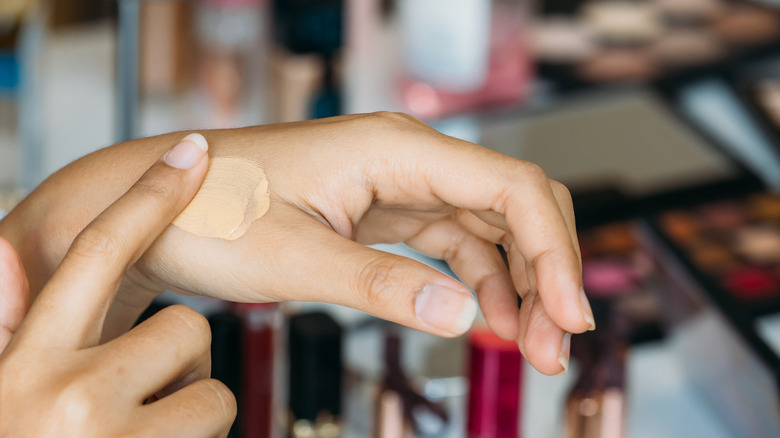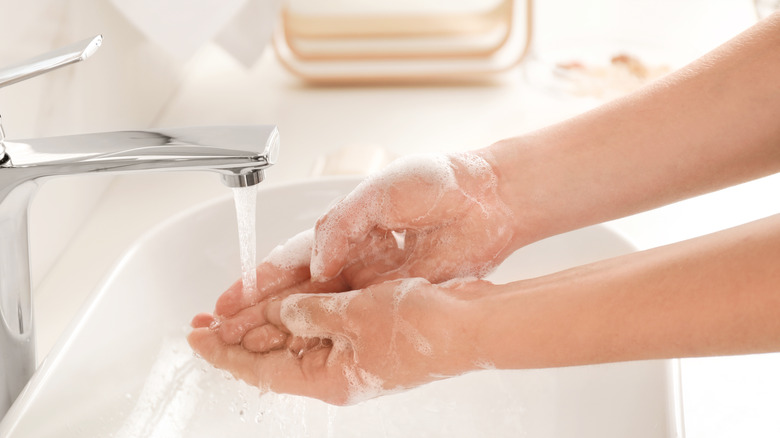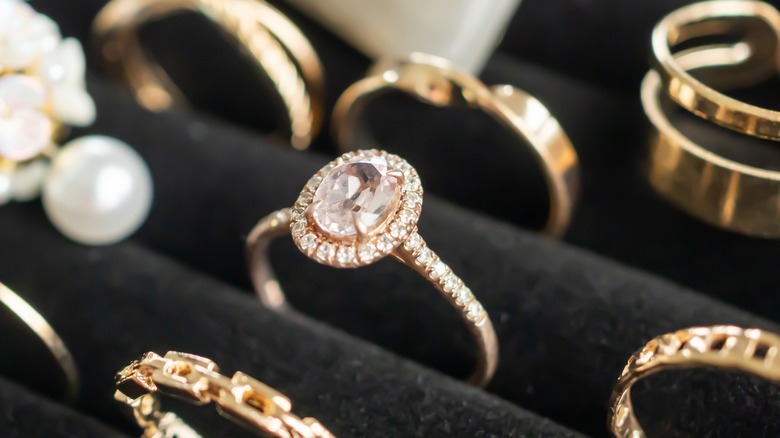Why Your Jewelry Is Turning Your Skin Green
Rings are one of the most searched jewelry items online, and it looks like the trend may be set to continue alongside the forecast future growth of the jewelry market. While you may be excited to invest in a new piece of bling, there are some unwanted effects that you may experience as a consequence, particularly if you wear your rings for long periods of time.
Time and time again, many jewelry owners have reported some bizarre effects as a result of wearing rings, or other items that sit close to the skin. One peculiar effect that is commonly experienced among jewelry wearers is "the green finger," an occurrence where the skin turns green around the ring area. Naturally, this peculiar occurrence can spark fear in many jewelry owners. Perhaps you're even wondering if it's dangerous. So, what causes such an unsightly mark, and how can you prevent it from happening again?
Copper and several other metals can cause greening
Knowing what metals cause greening skin will help you to sniff out any guilty culprits from your jewelry collection. So, which metals cause such an effect? One of the biggest and most common culprits of skin greening is copper. It is commonly found in a variety of jewelry, such as rings, necklaces, and earrings. A lot of fashion jewelry contains the material, as it is a much cheaper alternative when compared to other precious metals. Other guilty members include nickel and, sometimes, sterling silver. Although it's less commonly used, it's still found in a wide range of jewelry. If you're concerned about materials, there are some ways that you can choose the best metal for your rings.
However, why do these metals cause your skin to turn green? If you've noticed any green marks where your jewelry normally sits, this question has probably already crossed your mind several times. Such an occurrence can be worrying; however, there is a surprisingly simple explanation for what's happening.
Your greening skin is caused by the oxidization process
So, why is your jewelry turning your skin green? For most people, this is symbolized by a band of dark-hued green that wraps around a portion of the skin, usually where your jewelry sits. While it may look like a ghastly sight, it's actually nothing to worry about, and the explanation is surprisingly simple.
The green you're seeing on your skin is actually a result of a process known as oxidization. In scientific terms, this is when a chemical reaction occurs, resulting in the given compound gaining oxygen, but losing electrons. To put this in simpler terms, the green band you're seeing on your skin is the result of that very same chemical reaction occurring between your skin and the metal in your jewelry.
But what's with the green color? Again, this is caused by oxidization. The green tint you may be all too familiar with is caused by copper, or your given metal, reacting with oxygen and acids from your skin. This forms copper oxide. Once copper oxide is formed, it reacts with H₂O and carbon dioxide to form the green color that you see on your skin. This process is very natural, as your body produces slightly acidic sweat. However, the level contained is very much dependent on an individual's diet (via Healthline).
Makeup or other substances could trigger it
When your skin turns green after jewelry use, there may be another culprit: your makeup. While it is common for the metal in your jewelry to react with your skin, other substances could also react with the metals and aggravate the process. Some substances to look out for include makeup, hand lotion, soap, moisturizer, and perfume. All of these substances can have a knock-on effect and react with your jewelry, speeding up the process.
Often, it's the minerals and compounds within these products that react with your jewelry and can aggravate the chemical reactions, per JTV. So, if any of these substances are going near your jewelry, this could likely be the reason why you're seeing those pesky green marks on your skin where your jewelry often sits. If you suspect this is happening, try and keep your hands away from the products mentioned, and wash them thoroughly before wearing your glamorous pieces.
While the oxidization process can cause the greening of the skin, be careful not to confuse it with an allergic reaction. Reactions to metals are often marked by itchiness or redness of the skin, with nickel being a common culprit, explains Tori Dundas, the founder of the jewelry company True Curated Designs (via Reader's Digest). Knowing the difference between the two will help you to decide on the next steps that you want to take.
How to prevent jewelry from discoloring your skin
While it is easy to panic at the first sight of green skin, there is no reason to worry — it's not permanent. You can easily wash it off with a bit of warm water and soap, or alternatively, you can leave it to go away on its own (this shouldn't take too long). However, how can you prevent jewelry from turning your skin green in the first place?
First, you should keep your hands dry and avoid wearing your jewelry in any situations where you may become excessively sweaty, particularly around the areas of your body where you wear it. Another tip that dermatologist Jennifer Adams M.D. recommends is to recoat the jewelry with the original metal or use nail polish (via Nebraska Medicine). Reapply when you feel necessary or you notice any green bands appearing on your skin again. You can also try applying an extra layer of rhodium. Recoating should be done professionally. Both of these methods will help to add extra layers of protection. You should also avoid wearing your jewelry when washing up or swimming.
Try buying jewelry that erodes less easily
Although it might seem obvious, another great way to prevent skin discoloration is to avoid buying jewelry with copper, or any of the other metals listed above. Instead, opt for jewelry that erodes less easily, such as platinum or gold. These metals are much more resistant to corrosive effects such as oxidization, which will help to prevent that dreaded green finger! However, there are also other ways to prevent corrosion.
Storing your jewelry correctly is important if you want to maintain its quality. You should consider storage temperatures, and what metals you are storing together. Both of these factors can impact the longevity of your jewelry and how fast it corrodes. Of course, faster corrosion could lead to some skin discoloration — exactly what you want to avoid!
So, now you know why your jewelry is turning your skin green, you can take the right precautions to prevent it from occurring regularly. While having green skin may not be the most appealing sight, you can rest assured that it's easily fixable in most cases.
